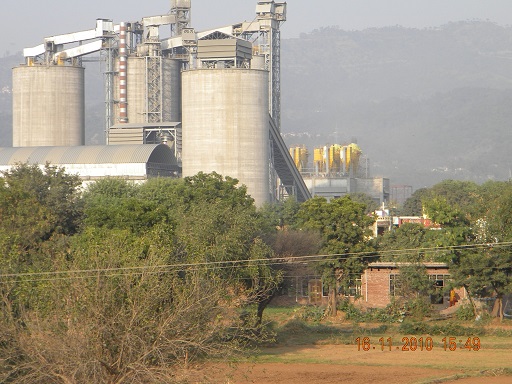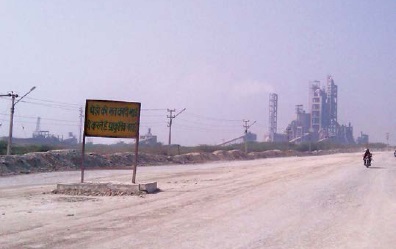Concrete Problems: Environmental Impacts of Municipal and Hazardous Waste Co-Incineration in Cement Processing Plants in India
 |
Global Alliance for Incinerator Alternatives (GAIA) |
 |
Anne Larracas |
 |
http://www.no-burn.org |
 |
JPY 400,000 |

Cement plant in Himachal Pradesh

Cement plant in Gujarat

Filter caught the dust
Research Background
This research project seeks to train community members to gather samples and data to document the toxic pollution impact of co-incineration in cement kilns in India, to challenge existing inadequate pollution monitoring and legislation.
World consumption of cement is forecast to expand over the next 15 years by approximately 56%. This projected growth is a matter of grave environmental concern. The global cement industry is a significant source of environmental pollution. CO2 emissions from cement production currently represent about 5% of anthropogenic global CO2 emissions. Apart from that cement production is also linked to severe toxic emissions like mercury, cadmium, barium etc, and dioxins.
Given the greenhouse gas emissions of the cement industry and its projected expansion, interventions for emission reduction have been proposed. One highly - touted intervention has been co-incineration - the replacement of conventional fuels like coal used in cement processing with municipal wastes and hazardous discards from industrial processes.
Not only is the positive impact of co-incineration on climate change doubtful, but co-incineration also has a negative effect on local environments and communities as a result of increased toxic emissions, which have been noted by researchers in several countries.
India has a substantial cement industry, consisting of 125 large cement plants with an installed capacity of 148.28 million tonnes and more than 300 mini cement plants. The major contributor to the cement industry of India is the state of Madhya Pradesh. The 19 cement plants in Madhya Pradesh contribute 26.23 million tonnes of cement to the total reservoir of cement in India. Andhra Pradesh has the maximum number of cement plants (20) and it contributes 17 million tonnes of cement to India. Rajasthan, Gujarat and Tamil Nadu have 16, 12 and 10 plants each and they collectively contribute 35.79 million tonnes of cement (Refer: Map, Cement Plants in India).
In 2010, the Central Pollution Control Board (CPCB) of India officially released the "Guidelines on Co-processing in Cement/Power/Steel Industry" which sanctioned the co-incineration of wastes in cement kilns. The approval for co-incineration across India is based upon inconclusive and shoddy trials carried out under the aegis of the industry and the CPCB. While the results of these official trials were uniformly within prescribed standards, a series of tests carried out by Chennai based non-profit Community Environmental Monitoring found heavy metal contamination around cement processing plants in Himachal Pradesh and TamilNadu (results available upon request). These samples were taken with the help of local communities and analysed at Chester Labs, Oregon USA. The results proved that emissions from cement plants using conventional fuels are also a matter of concern.
While this data provides information on emissions from kilns using conventional fuels, further data is necessary to strengthen these initial findings and for data on co-incineration. Secondly the impact of such additives on the clinker (final product) also needs to be analyzed especially because this has a direct impact on the construction and housing sector. This expands the implications of any toxic processes in the cement industry.
The proposed research aims at a comprehensive scientific analysis of emissions from cement plants across India where co-incineration is practiced. Monthly dust samples using a community pollution monitoring device called the MiniVol will be used along with weekly swipe samples. The data will be further strengthened with daily monitoring by community residents who will document environmental impacts using common senses of sight, smell and hearing.
This data and approach will be compared with monitoring and sampling data from key state pollution control boards, which often to do not have standardized procedures for regular monitoring. While monitoring bodies have been resistant to community complaints, publication of citizen reports/findings has been successful in urging government bodies to be more proactive in producing or improving their own data. This has resulted in the authorities engaging with the citizens instead of dismissing their claims. [Sep. 2011]
Final Report (abstract)
In 2010, Indian Central Pollution Control Board (CPCB) released the "Guidelines on Co-processing in Cement/Power/Steel Industry" which gave an official sanction for co-incineration of industrial and municipal wastes in cement plants. This directive will effectively allow cement plants across India to incinerate a range of hazardous, post-production waste from manufacturing and a variety of post consumer municipal waste.
We attribute this initiative of the CPCB to a global trend in cement kiln co-incineration. The primary proponents of cement kiln co-incineration globally are the cement industry led by Holcim, La-Farge and Cemex in association with the Deutsche Gesellschaft fur Internationale Zusammenarbeit (GIZ), Germany. This consortium makes two key arguments on waste co-incineration:
a) Using alternate fuel or waste would reduce climate footprint of the rapidly growing cement industry
b) By diverting waste to cement manufacturing it provides a short-term fix to the growing menace of municipal and manufacturing waste being faced by the cities and industry.
The CPCB's proposal for co-incineration has been endorsed by GIZ across India. It is based on the certain assumptions about manufacturing and waste disposal methods in India:
- The existing operations of the cement plants are non-polluting.
- Toxic by-products resulting from burning of waste will be destroyed under high temperatures of the kiln.
- The current technologies for monitoring/incinerating are sufficiently advanced to allow hazardous waste burning with no additional pollution load; and that these technologies will be deployed wherever co-incineration is permitted.
- The existing monitoring/enforcement infrastructures are robust enough to detect and tackle violations.
The most important assumption is that CPCB had carried out due diligence to assess the state of existing plants for their ability to burn hazardous waste.
Indian cement plants have been known to pollute even without co-incineration of waste. A series of ambient dust samples taken prior to the commencement of this project in Himachal Pradesh and Tamil Nadu between 2008 and 2010 found high levels of fine particulate pollution and toxic heavy metal contamination around plants using conventional fuel like coal . These findings not only proved that emissions from cement plants using coal were excessive but also the highlighted the poor regulatory mechanism, which allowed such a situation to persist for years. This exposes the poor state of affairs as far as regular monitoring of cement plants is concerned and also raised several questions about the capacity of the regulatory agencies especially the CPCB to ensure strict emission monitoring that was assured while sanctioning waste co-incineration (refer CPCB guidelies document). It also raises several doubts on the due diligence carried out by the GIZ before collaborating and recommending co-incineration of waste in Indian cement kilns.
Further, a preliminary investigation into the due diligence followed by CPCB before sanctioning the practice revealed that it to be based on a few trial runs conducted with poor scientific rigour. The process was non-transparent and non-inclusive as it failed to seek comments from the public or conduct any consultation with communities living around cement plants. Trial runs with the most toxic and explosive chemicals were conducted without public and in some cases the without workers knowledge and in the absence of accident management plans.
The study is primarily targeted to verify the 3 main claims made by CPCB before granting approval to co-incineration in Cement plants.
1.Assess the nature of pollution from the cement plants using conventional fuel;
2.Assess the effectiveness of the monitoring mechanisms employed by the state pollution control agencies where these plants are located.
3.Assess the capabilities of the CPCB in monitoring and regulating the co-incineration of hazardous waste in the cement units in the long run.
The findings of earlier samples taken in Himachal Pradesh and Tamil Nadu between 2008 and 2010 had already provided an inkling of the state of affairs as far as regulation and monitoring was concerned but it was necessary to widen the study area to few more regions in order to establish a trend. Given that co-incineration of hazardous waste had begun on trial basis in some of the plants, efforts were also made to reach out to workers and communities in those localities to understand the nature of operations and impacts of pollution from those units.
[Jan. 2014]
Others
